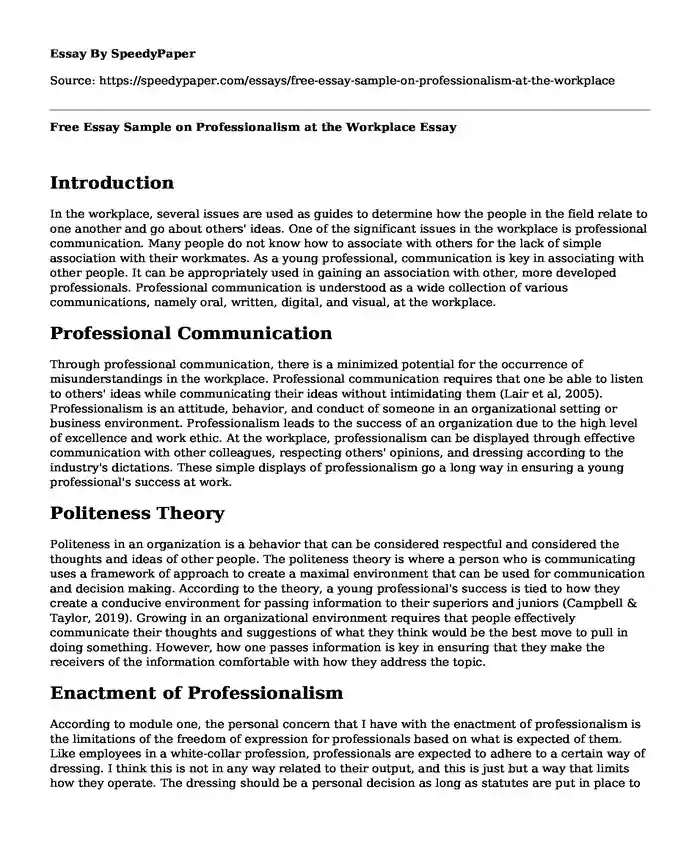
| Type of paper: | Essay |
| Categories: | Human behavior Professional development Social issue |
| Pages: | 3 |
| Wordcount: | 715 words |
Introduction
In the workplace, several issues are used as guides to determine how the people in the field relate to one another and go about others' ideas. One of the significant issues in the workplace is professional communication. Many people do not know how to associate with others for the lack of simple association with their workmates. As a young professional, communication is key in associating with other people. It can be appropriately used in gaining an association with other, more developed professionals. Professional communication is understood as a wide collection of various communications, namely oral, written, digital, and visual, at the workplace.
Professional Communication
Through professional communication, there is a minimized potential for the occurrence of misunderstandings in the workplace. Professional communication requires that one be able to listen to others' ideas while communicating their ideas without intimidating them (Lair et al, 2005). Professionalism is an attitude, behavior, and conduct of someone in an organizational setting or business environment. Professionalism leads to the success of an organization due to the high level of excellence and work ethic. At the workplace, professionalism can be displayed through effective communication with other colleagues, respecting others' opinions, and dressing according to the industry's dictations. These simple displays of professionalism go a long way in ensuring a young professional's success at work.
Politeness Theory
Politeness in an organization is a behavior that can be considered respectful and considered the thoughts and ideas of other people. The politeness theory is where a person who is communicating uses a framework of approach to create a maximal environment that can be used for communication and decision making. According to the theory, a young professional's success is tied to how they create a conducive environment for passing information to their superiors and juniors (Campbell & Taylor, 2019). Growing in an organizational environment requires that people effectively communicate their thoughts and suggestions of what they think would be the best move to pull in doing something. However, how one passes information is key in ensuring that they make the receivers of the information comfortable with how they address the topic.
Enactment of Professionalism
According to module one, the personal concern that I have with the enactment of professionalism is the limitations of the freedom of expression for professionals based on what is expected of them. Like employees in a white-collar profession, professionals are expected to adhere to a certain way of dressing. I think this is not in any way related to their output, and this is just but a way that limits how they operate. The dressing should be a personal decision as long as statutes are put in place to ensure that people maintain dressing that does not make other people around them uncomfortable (Monrouxe & Rees, 2017). I think someone dressing in tennis shoes to an interview should not be viewed as a wrong first impression; instead, the person should be judged according to what they can achieve and, in turn, assist the organization in achieving its goals.
Conclusion
Some of the challenges that my colleagues and I face in enacting professionalism assume that the other person has the ball. As professionals in the office, some tend to assume that someone else will handle the task when a project is given to a group. The assumption that someone else will handle the ball always ends in the ball, eventually dropping, leading to losses (Kramer & Hess, 2002). Another challenge is in the failure to self-edit; whenever someone fails to acknowledge and edit what they have to say to the others always leads to problems among peers and breakdown in communication. These enactment problems can be solved by clarifying roles for everyone in groups and workmates checking their tones when addressing issues.
References
Campbell, S. L., & Taylor, D. (2019). Professionalism in the workplace. https://www.umkc.edu/starr/Workplace_Professionalism.pdf
Kramer, M. W., & Hess, J. A. (2002). Communication rules for the display of emotions in organizational settings. Management Communication Quarterly, 16(1), 66-80.
Lair, D. J., Sullivan, K., & Cheney, G. (2005). Marketization and the professionalization of self. Management Communication Quarterly, 18, 307-343.
Monrouxe, L. V., & Rees, C. E. (2017). Healthcare professionalism: improving practice through reflections on workplace dilemmas. John Wiley & Sons.
https://books.google.com/books
Stephen F. Austin State University, (2019). Communication Studies: Module one. Elizabeth Spradley.
Cite this page
Free Essay Sample on Professionalism at the Workplace. (2023, Nov 24). Retrieved from https://speedypaper.net/essays/free-essay-sample-on-professionalism-at-the-workplace
Request Removal
If you are the original author of this essay and no longer wish to have it published on the SpeedyPaper website, please click below to request its removal:
- Free Paper with the Case Study of Charles Manson's Deviant Behavior
- Free Essay Example - Children Psychology
- Essay Sample on How Leaders Manage and Balance the Duties
- Paper Example: Pit bulls Should Not Be Banned in the United States
- How Can Environmental Design Reduce Crime? Essay Example
- Essay Sample - The Behaviors of the Children
- Argumentative Essay on the Video Gaming among Teenagers - Free Essay
Popular categories




